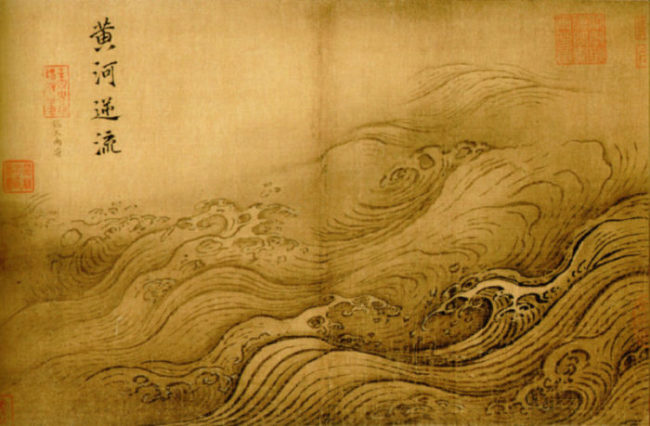Featured image: The Yellow River Breaches its Course by Ma Yuan, Public Domain
Paper: Uranium isotopic constraints on the nature of the prehistoric flood at the Lajia site, China
Authors: Le Li, Jun Chen, David William Hedding, Yuanhe Fu, Maolin Ye, Gaojun Li
Chinese legend holds that the leaders who worked to control a giant flood on the Yellow River (known in China as the Great Flood) also founded the Xia Dynasty–the first centralized state in Chinese history– about 4,000 years ago. Proving that the Great Flood actually happened would lend weight to ancient historical accounts of the founding of the dynasty, but the evidence is still up for debate.
Some geologists argue that an earthquake caused the Great Flood. The story goes that the earthquake triggered landslides that dammed the Yellow River until the dam finally broke, releasing about 16 cubic kilometers (four million Olympic-sized swimming pools) of water virtually all at once.
Sediments thought to have been carried downriver by the outburst flood have been found in fissures—cracks in the ground caused by the earthquake—at an ancient human settlement that the earthquake destroyed. Human remains from the site have been dated to about 3,900 years old. Proponents of the earthquake-caused Great Flood theory say that the sediment-filled fissures link the earthquake and the flood, thereby giving us the birthday of the centralized Chinese state.
But some of the evidence for the theory that the earthquake and flood are related is controversial. Opponents argue that the timing of the earthquake (and therefore the dates on the human remains) can’t be directly linked to the flood because the sands in the earthquake fissures might not be sediments from a giant flood. Instead, they say, the sand might have just washed down from nearby gullies.
A new paper now argues that the sand in the earthquake fissures can be chemically linked to sources up the Yellow River, providing a strong link between the earthquake and the Great Flood.
Le Li and coauthors used a new geochemical technique to test whether the sand came from nearby gullies, or from upstream in the Yellow River. They measured the ratio of two different isotopes of uranium (uranium-234 to uranium-238) in the sand; this ratio decreases with the time since the sediments were broken off from rock and can help distinguish different sources for the disputed, fissure-filling sediment.
The isotopic ratios of the fissure sands closely match those found in Yellow River sediment but not those found in local gully material. The new results support the idea that previously dated human remains accurately reveal the timing of a massive flood, and that the flood was caused by the breaking of an earthquake-induced landslide dam.
While the new study adds to the evidence that a giant flood did occur around 4,000 years ago, the extent to which it contributed to the foundation of the Chinese nation-state may be lost to history.

What Caused the Flood that Gave Rise to an Empire? by Charlie Shobe is licensed under a Creative Commons Attribution-ShareAlike 4.0 International License.

